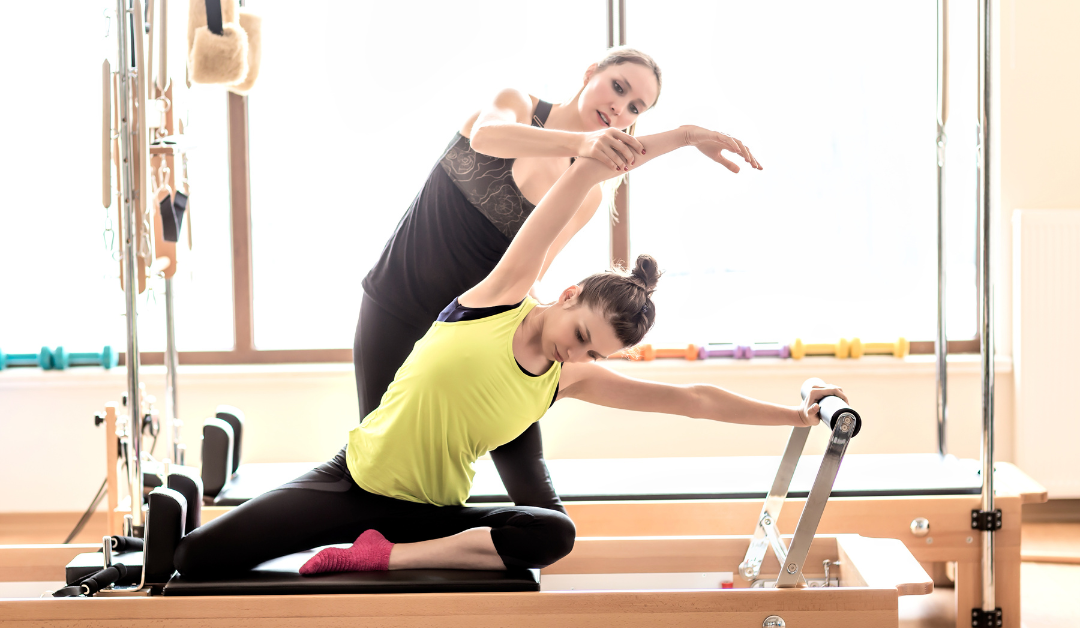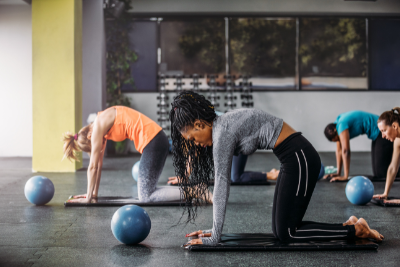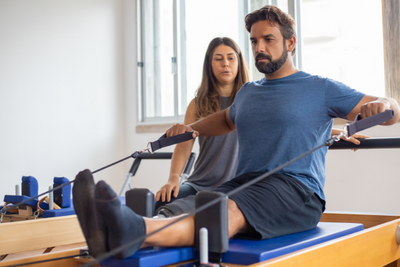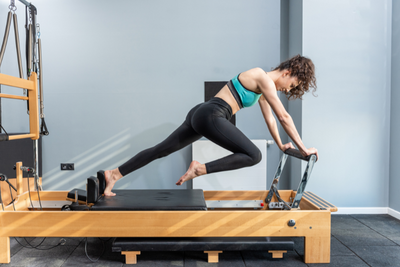You may have heard a little about Pilates and noticed how popular it has become, but how do you know if it is right for you?
Pilates is an exercise system that can help you both physically and mentally, from improving flexibility, core strength, balance and body awareness, to boosting your mental health. Not to mention, help you lose a few cm around the waist and hips!
In this article we’ll give you an overview of what Pilates is, the benefits, types of classes, show you some beginner exercises and explain what you need to know to get started. Welcome to the amazing world of Pilates!
What is Pilates?
Pilates is a full body workout that helps you deal to the everyday demands of life better! It strengthens and stabilises your core, so you can move more efficiently, and improves your posture, flexibility, and mobility.
Pilates was developed in the 1920s by Joseph Pilates with the main purpose of rehabilitation. It was originally called ‘Contrology’ – the art of controlled movement – and the aim was to improve flexibility, develop control and build strength and endurance.
The core principles of Pilates are breathing, centering, concentration, control, flow, posture alignment, relaxation, precision and stamina.
Pilates works the entire body, as while you are stabilising one body part, you are moving another. Movements will start smaller at the start and increase gradually with experience and strength. Your focus should be on quality not quantity, and to perform exercises with precision and control.
The Pilates workout consists of a variety of usually small and simple exercise sequences that are performed in low repetitions, usually five to ten times, over a session of 30 to 90 minutes. There are approximately 500 exercises to draw from, originally inspired by calisthenics, yoga and ballet, that aim to lengthen and stretch all the major muscle groups in the body in a balanced fashion. In Pilates, your muscles are not usually worked to exhaustion, so usually there is little sweating or straining, just intense concentration and a strong focus on alignment, posture, breathing and technique.
What are the main Benefits of Pilates?
The core benefits of Pilates are improved balance, flexibility and core strength.
Through Pilates you increase the length and stretch of your muscles and joints, which results in great flexibility and you becoming longer and leaner!
Better posture is also another main benefit, which comes from improving your upper back support. Pilates forces you to align your spine and strengthen neglected postural muscles.
But apart from all the direct physical benefits, there are also a long list of health benefits that flow on from there.
Here are the top 10 additional benefits of Pilates
- Decrease Back Pain
- Support Injury Rehabilitation and Prevention
- Improve Balance
- Enhance sports performance
- Increase Energy
- Maintain health weight
- Improve concentration
- Improve Mind/Body awareness
- Relieve Stress
- Boost Self Esteem and Mental Health
Who can do Pilates?
Pilates can suit everybody from elite athletes, to pregnant women or teenagers!
Pilates offers numerous benefits for all people, regardless of fitness level, sex, age or experience. It is such a versatile form of exercise, with a vast array of exercises and variations, equipment options and class structures to suit everyone.
How is Pilates different from other fitness regimes?
- Unlike other fitness regimes, Pilates gives you a full body workout each time. Whether on a reformer or mat, your instructor will provide exercises that work an array of areas on every side of your body.
- With over 500 exercises and various modifications on each exercise to suit each level of fitness, Pilates is extremely flexible and fresh, so you’ll never get bored! You can also personally adjust your workout depending on how you are feeling also. Just speak to your instructor or take the option that suits you. Then when you feel ready for a challenge, you can step up the difficulty or ask for a more difficult exercise.
- Pilates is fun and rarely will you walk away feeling deflated or beyond exhausted. The environment is usually supportive and friendly with various other like minded people.
- Pilates is never competitive and the challenges lie with you and your body only.. and possibly the pilates equipment you are working on!
- Pilates can be done in a Pilates studio, a Gym, a Physiotherapy clinic, a recreational hall, or even at home, so you have many options to choose from!
How long will it take to see results?
As Joseph Pilates famously said “In 10 sessions you will feel a difference, in 20 sessions you will see a difference, in 30 sessions you will have a whole new body.”
Your results will depend on many factors, such as mindset and nutrition, but generally speaking, you will see body tone results between 3 and 8 weeks. Of course your mind and body will start to feel better almost immediately however, and your posture should also start to improve very quickly.
What types of classes are there and how often should I go?
Mat Pilates is a class on a mat or yoga mat, performing body weight exercises and movements low to the ground. Mat pilates provides resistance against gravity and strengthens all areas of the body. By using your own body as resistance, you’ll learn how to engage specific muscles to complete your exercises with the proper form. Instructors may choose to also use props like the magic circle, weights, swiss ball or therabands.
Reformer Pilates, is Pilates performed on a Reformer machine, whilst Equipment or Clinical Pilates (also known as Clinical Physiotherapy), is performed using a range of equipment, like the Reformer, Trapeze or Tower, and Pilates Chair or Wunda Chair. The apparatus mostly uses springs for resistance, and allows you to perform a whole range of workouts in many different positions so it is dynamic and versatile.
Some say that starting with the mat pilates class is better as it teaches you the foundation to Pilates, however others recommend some one-on-one equipment classes with a Physiotherapist as an ideal way to get started. Either way, it is very important to master the basics like breathing first and activating your deep muscles, before moving onto a larger class or performing your own pilates at home.
Each class will be different, focusing on various areas and levels of difficulty. Listen to your body and see how your recovery goes before deciding how often to practice pilates. A consistent practice of 3 times per week is ideal for most, however some people choose to practice daily if their body and budget allow.
At SPHC we offer a range of Pilates classes to suit all levels and preferences. Read more about them below –
SPHC Lifestyle Pilates Class Sneak Peek!
Simple Pilates Exercises for Beginners
There are a variety of basic Pilates exercises that are common in beginner classes including the Hundred, Roll up, and Leg Circles. Here is one of our previous articles with some example videos – Popular Equipment Pilates Exercises for Beginners
What can I expect from my first class?
When booking your first class, ask your instructor or receptionist what you need to bring along and if any paperwork is required prior to your class.
Generally you will just need to bring a towel, water bottle and pilates mat for mat pilates. Most studios will require you to wear grip pilates socks on the equipment for safety reasons. Wear comfortable exercise clothes, and more form fitting clothes if using the equipment so that they don’t get caught in the springs.
There will be training provided in order to use the equipment safely and your instructor will take you through the fundamentals of Pilates so that you can start with the basics, and not feel overwhelmed. If you feel unsure that you are doing the exercise correctly, ask your instructor to check, and feel free to ask more questions after class as needed.
Your class will consist of a range of small and precise movements that may not seem difficult, but they will progress to a higher level of difficulty once you are more comfortable. Whilst pilates is considered low impact, you will most likely feel sore the following day and in areas you didn’t even know you had muscles!
How to Get Started with your first Pilates class at SPHC!
Our SPHC Pilates Mat and Equipment classes are conducted by fully qualified and experienced Physiotherapists or Pilates Instructors using the highest quality Pilates equipment available.
For more information browse through our website or give us a call on 3869 1099.




